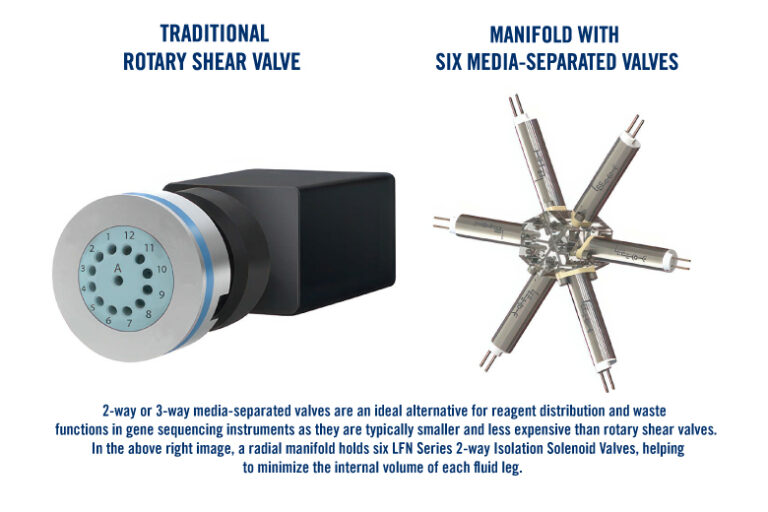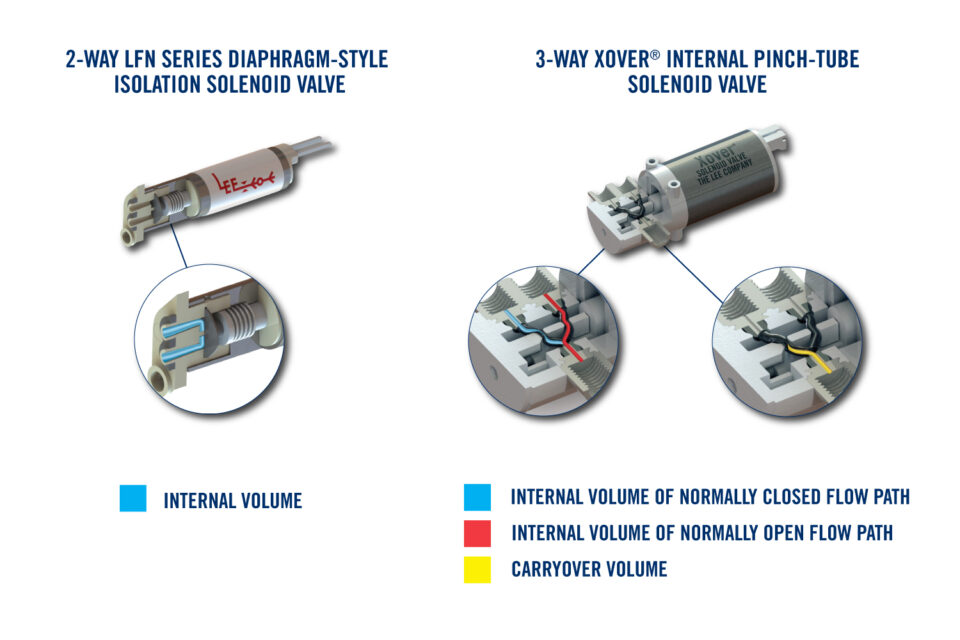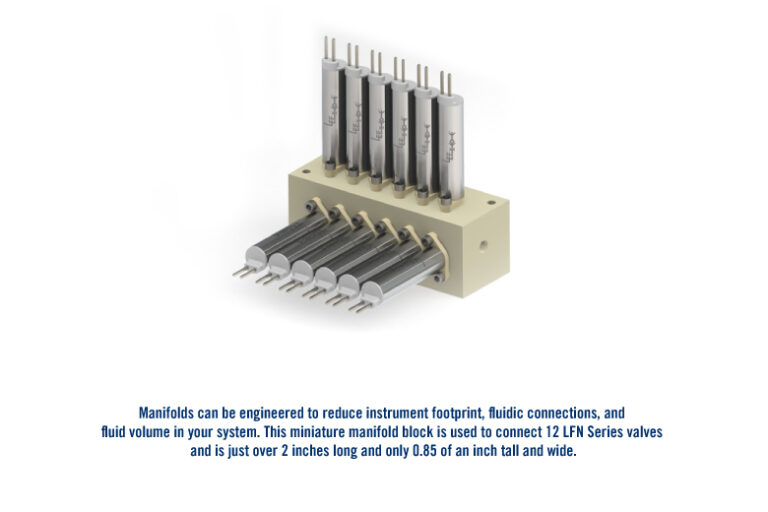Unlocking the language of DNA can allow us to understand better mutations in our genome that may cause future disease or illness – and how we can better diagnose and treat them. Scientists can use genome sequencing to obtain critical information to aid in cancer research, use proteomics to identify biomarkers in disease, and even replicate RNA to create life-saving vaccines.
Modern advances in gene sequencing and DNA/RNA synthesis technology have brought an industry-wide push to make the instruments used in these processes smaller, more efficient, and less expensive. Next-generation sequencing (NGS) instruments, sample and library preparation instruments, and DNA/RNA synthesis instruments are just a few examples of the technology helping to bring about this genomic revolution. Media-separated solenoid valves (also known as isolation solenoid valves and inert valves) are a crucial fluidic component within these instruments. These solenoid valves flow and dispose of challenging fluids such as dimethyl sulfoxide (DMSO) or acetonitrile on each device’s reagent distribution and waste sides.

Historically, instruments commonly used large, expensive rotary shear valves (also known as selector or rotary valves) for reagent distribution and waste functions. To make instruments smaller and reduce overall fluid volume, many designers are looking at using 2-way and 3-way media-separated solenoid valves instead. This article is designed to discuss key factors to consider for gene sequencing or synthetic DNA/RNA applications, focusing specifically on diaphragm-style and pinch-tube-style inert valves, which are available in 2-way (2/2,“on/off”) or 3-way (3/2) configurations.
Elements such as valve internal and dead volume, response time, design flexibility, and lifespan can impact the function of gene sequencing and synthesis instruments.
Internal volume refers to the total wetted fluid volume within the fluidic component. This includes dead volume (the volume of fluid that is not easily flushable) and swept volume (the volume of fluid in all flow paths).
Low internal volume is an important factor for chemical processes that require expensive reagents or where reagents are sensitive to cross-contamination. It is particularly significant in the reagent distribution side of smaller instruments. Having as low an internal volume as possible can help to reduce the cost of goods by minimizing reagent usage, waste, and general fluid volume within an instrument. The less volume of waste produced, the faster it can be removed, resulting in more cycles to help boost overall throughput.
A factor specific to 3-way valve configurations is carryover volume or the unwashed slug of fluid between the flowing passage and the seal of the other closed port. Volume carried over can mix with other fluids and is subsequently wasted when it is flushed out. When running multiple reagents through a valve, cross-contamination can occur if the valve is not fully flushed or if there is inherent dead volume within the valve. This can cause an unintended chemical reaction between reagents that may lead to issues in a downstream process. In 3-way solenoid valve configurations, internal pinch-tube-style valves help to minimize cross-contamination. New models have ultra-low carryover volume (as low as 3.7 μL) with zero dead volume.
In contrast, rocker-style 3-way valves – a subset of diaphragm isolation valves with a rocking mechanism that opens the flow path from one port to another – commonly contain an amount of dead and carryover volume by nature of their design.

Low internal volume helps minimize an instrument’s reagent usage, waste, and fluid volume. A valve designed with zero dead volume and ultra-low carryover volume can help reduce cross-contamination in a system. Pinch-tube-style media-separated valves (such as the Xover valve) are fully flushable. They can help reduce flow pulsations and maintain steady laminar flow compared to diaphragm-style valves.
Whether 2-way or 3-way, solenoid valve designs with zero dead volume are beneficial because they can be easily flushed during a wash cycle. Fluids prone to crystallization or mixtures that generate precipitate are, therefore, less likely to clog the flow path or damage a valve’s sealing surface if they are adequately flushed. A pinch-tube-style valve is the easiest to flush since the fluid flows exclusively through a cylindrical (tube) flow path.
A valve’s response time (or “switching time”) is the time it takes to transition from one flow state to another (e.g., from closed to open in 2-way valves). Overall performance is directly impacted by the speed at which the valve can reliably transition between processes or modes, such as running samples, reagents, and cleaning or buffering solutions. Faster switching allows tighter system control of the volume moved while the valve is open. It also provides time for more cycles to be completed, resulting in more tests per hour and higher overall throughput.
Pinch-tube-style valves typically have a slower response time than diaphragm-style valves, which open and close simply by pulling the diaphragm off the valve seat via a plunger. For example, Lee engineers have observed response times of less than 10 ms in Lee diaphragm-style valves compared to Lee pinch-tube-style valves (20 to 40 ms). Spike and hold circuitry can reduce response times of some miniature solenoid valves to sub 5 ms and even as fast as 2-3 ms, depending on system conditions. Internal pinch-tube-style media-separated valves can help to reduce flow pulsations and maintain steady laminar flow, thereby preserving cell vitality and cell alignment in a sheath fluid (e.g., in spatial biology or flow cytometry) or in applications where more turbulent flow could disturb microfluidic reactions of reagents (PCR).
Integrating fluidic components into a manifold solution can reduce instrument footprint while enhancing functionality within a limited space. Manifold-mounted valves help decrease the tubing needed in a system, saving space in applicable instruments and reducing fluid volumes (and their associated costs).

A media-separated valve’s Cv rating should be appropriate to system flow needs. Minimum passage size should also allow sufficient diameter to flush media within the valve itself properly. Pinch-tube-style media-separated valves allow full flushability and laminar flow; diaphragm-style valves are harder to flush, but may be smaller, faster, and less expensive.
A media-separated valve designed to outlast its instrument’s life requires less preventative maintenance. In turn, this lessens the total cost of ownership for the instrument. The tubing in external pinch-tube-style valves can be replaced if damaged, but preventative maintenance can be costly over time. On the other hand, internal pinch-tube-style valves are designed to last the life of an instrument, thereby minimizing costly instrument downtime required for replacements.
The lifespan of a pinch-tube or diaphragm-style media-separated valve is generally affected by two factors: what is run through it and how it is run. Rapid cycling, input pressures, high temperatures, challenging fluids, and other influences can all make the valve wear down faster. Consideration should be paid to the life test conditions warranted by the manufacturer.
For example, a solenoid valve with a higher duty cycle consumes more power and leaves less time for heat dissipation. Valves close to reagents or processes sensitive to heat exposure may also cause problems if active cooling or power-reducing circuitry is not implemented. Corrosive fluids may eventually degrade the internal materials of the valve.
Wetted materials will come in contact with fluid in the inert flow path of a media-separated valve. This includes the valve housing and the elastomer seal materials that will come in contact with the chemical reagents flowing through the valve. Common wetted materials used in these types of valves include FFKM, FKM, EPDM, PTFE, and PEEK.
The biggest driver of material selection is fluid compatibility. When flowing wash buffers, chloride (CL), sodium hydroxide, acetonitrile, DMSO, or other chemicals through a media-separated solenoid valve, due diligence is needed to confirm chemical compatibility between wetted paths and chosen reagents. Ensuring compatibility helps to prevent chemical attacks within the instrument itself. The Lee Company can provide material samples for soak testing, enabling consumers to test compatibility with their specific reagents.
Media-separated solenoid valves play an important function within gene sequencing and synthesis instrumentation that helps propel processes forward – from the creation of oligonucleotides using chemical or enzymatic DNA synthesis to whole genome sequencing used to provide researchers and doctors with detailed information about the human body. For more information on pinch-tube and diaphragm-style media-separated valves offered by The Lee Company, please see our Xover® Internal Pinch-Tube Solenoid Valve, LFN Series 2-way Isolation Solenoid Valve, LFR Series 3-Way Isolation Solenoid Valve, LFV Series 2-Way Isolation Solenoid Valve, and LSP Series 2-Way Isolation Solenoid Valve.
Our global sales force of technical sales engineers is available to provide fast, accurate customer assistance and help you find the best solution for your fluid control challenge.
Always verify flow calculations by experiment.
*There are many parameters to consider when determining V-Factor. Click here for more information.
